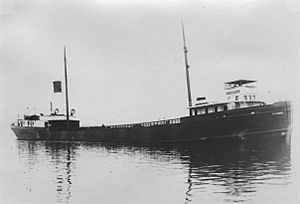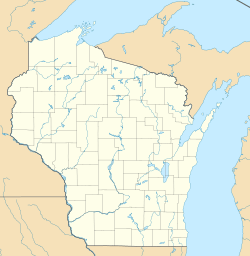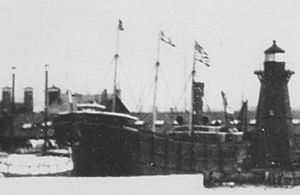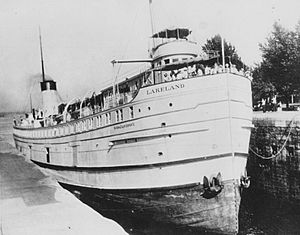SS Lakeland facts for kids

The Lakeland when she was named Cambria
|
|
Quick facts for kids History |
|
|---|---|
| Name |
|
| Operator | Tri-State Steamship Company |
| Builder | Globe Iron Works Company |
| Yard number | 12 |
| Launched | February 1, 1887 |
| In service | June 1, 1887 |
| Out of service | December 3, 1924 |
| Identification | U.S. Registry #126420 |
| Fate | Sank on Lake Michigan |
| General characteristics | |
| Class and type | Bulk Freighter |
| Tonnage |
|
| Length | 300.6 feet (91.6 m) |
| Beam | 39 feet (12 m) |
| Depth | 24 feet (7.3 m) |
| Installed power | 2 × Scotch marine boilers |
| Propulsion | 1,200 horsepower triple expansion steam engine |
|
LAKELAND (steam screw) Shipwreck
|
|
| Location | Door County, Wisconsin |
| Nearest city | Sturgeon Bay, Wisconsin |
| Built | 1887 |
| Architect | Globe Iron Works Company |
| Architectural style | Freighter |
| MPS | Great Lakes Shipwreck Sites of Wisconsin MPS |
| NRHP reference No. | 15000403 |
| Added to NRHP | July 7, 2015 |
The SS Lakeland was a large cargo ship that sailed the Great Lakes. It was one of the first ships built with a steel hull. On December 3, 1924, the Lakeland sank in Lake Michigan near Sturgeon Bay, Wisconsin. It went down into water about 205 feet (62 m) deep after it started leaking. The shipwreck of the Lakeland is now a special historical site. On July 7, 2015, it was added to the National Register of Historic Places.
Contents
Building a Great Lakes Giant
The Lakeland was first called the Cambria. It was built in 1887 in Cleveland, Ohio. The Globe Iron Works Company constructed it. This ship was special because it was one of the very first Great Lakes freighters made of steel.
The Cambria was also a record-breaker. It was 300.6 feet (91.6 m) long, making it the first 300-foot ship on the Great Lakes! It was 39 feet (12 m) wide and its cargo area was 24 feet (7.3 m) deep. The ship was powered by a 1,200 horsepower steam engine. This engine used two large boilers that burned coal.
Launch and Early Life
The Cambria was launched on February 1, 1887. It was the second steel-hulled ship built by the Globe Iron Works Company. It was also the first Great Lakes freighter to have a special "triple expansion" steam engine. This type of engine was very powerful for its time.
The Cambria was designed to carry many different types of goods. It hauled iron ore, coal, grain, and salt. Later, it even carried automobiles.
In June 1888, the Cambria had a problem. It ran aground (got stuck) about 2 miles (3.2 km) southwest of Peninsula Point Light on Lake Michigan. It was carrying 2,334 tons of iron ore. The accident caused a hole in its hull.
Changing Roles and Names
In 1910, the Cambria was taken to Milwaukee to be changed into a passenger ship. However, the work couldn't be finished there. A special tugboat named the Favorite had to tow it to Cleveland to complete the changes.
In May 1910, the ship got a new name: the Lakeland. A few months later, in September 1910, the Lakeland crashed into another ship, the John Smeaton, in the St. Marys River. After the crash, the Lakeland ran aground.
By early 1920, the Lakeland changed its job again. It stopped carrying passengers and started carrying cars instead.
Repairs and Upgrades
The Lakeland did not sail during the 1923 season. It was undergoing a major repair and upgrade. Its boiler room was moved, and a new watertight bulkhead was installed. This is a wall inside the ship that helps keep water out if there's a leak.
The ship also got two new boilers and a new pilothouse (where the captain steers). Its ballast pump was fixed, and some cracked parts of its frame were replaced. In the fall of 1924, the Lakeland went to a dry dock in Detroit, Michigan. Workers fixed a twisted rudder part and checked its entire hull.
The Final Journey
On December 3, 1924, the Lakeland was sailing across Lake Michigan. The weather was calm. It was traveling from Chicago, Illinois, to Detroit, Michigan. Its cargo was 22 Nash and Kissel cars, plus 1 Rollin car, all stored in its hold.
The ship had been leaking a little, but it was under control. Then, around 11:30 AM, the Lakeland suddenly sprang a very serious leak. The crew tried to pump the water out as fast as they could. But the leak was too big. Captain John McNeely had to turn the ship around. He hoped to reach shallow water before it sank.
When the Lakeland was about 9 miles from shore, it was clear the ship couldn't stay afloat much longer. Some of the crew got into lifeboats to escape. Another ship, the Ann Arbor No.6, came to help. The Coast Guard also arrived. The Lakeland was tilting dangerously to one side. Captain Robert Anderson of the Coast Guard ordered the remaining crew to climb onto his cutter.
The Lakeland then sank stern first (back end first) and broke into two pieces. Its lights flickered and then disappeared under the water. As it sank, the radio operator on the Ann Arbor No.6, Elliot Jacobson, took some photos.
Investigation and Discovery
In mid-1925, the insurance company that was supposed to pay the Lakeland's owners a lot of money started looking for the wreck. They wanted to find out why it sank. Two fishing tugs, the Albert C. and the Four Brothers, eventually found the shipwreck.
Special divers used new technology with helium and oxygen to explore the wreck. This was one of the first times this type of mixed gas diving was used in the Great Lakes. The divers found that some of the ship's valves, called seacocks, had been opened before it sank.
The company that owned the Lakeland was taken to court by the insurance companies. They wanted to understand what happened. The case went to court twice, and the findings eventually favored the Lakeland's owners. It is believed that the insurance companies and the ship's owners later reached an agreement outside of court.
The Lakeland Today
The wreck of the Lakeland was found again in 1960. It sits upright on the bottom of Lake Michigan, in about 205 feet (62 m) of water. Its steel hull is almost broken in two behind the cargo elevator. The wooden parts of the ship that were on the upper deck are gone. This happened because when the ship sank, air trapped inside these wooden parts blew them off the hull.
The front part of the ship's passenger deck has several cracks. These cracks allow divers to go inside the wreck. In the 1970s, a 1924 Rollin car was brought up from the wreck. However, there were problems during the salvage, and the car ended up going to a scrapyard.
Another item saved from the Lakeland was its brass steam whistle. This whistle is now on display at the Door County Maritime Museum. The ship's anchor was also brought up. There are still Nash and Kissel cars inside the ship's cargo hold today!
Near the Lakeland wreck, you can find other shipwrecks. These include the large wooden cargo ships Australasia and the Frank O'Connor. Also nearby are the wooden steamer Louisiana, which sank during a big storm in 1913, the schooner Christina Nilsson, and the steamboat Joys.
Historic photos of the Lakeland





